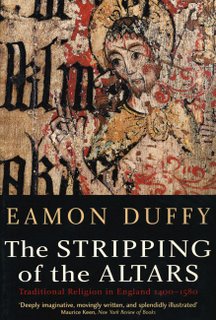 Outside of theological departments few Christians will perhaps have ever heard of 'the Book of J'. One of the interesting products of nineteenth century Biblical scholarship was a close attention to the composition of the Bible.
Outside of theological departments few Christians will perhaps have ever heard of 'the Book of J'. One of the interesting products of nineteenth century Biblical scholarship was a close attention to the composition of the Bible.Julius Wellhausen first systematized the theory (called the Documentary Hypothesis) that within the first five books of the Bible (the Torah/Pentateuch) at least four different textual strands can be seen.
He (and others before him) began by noting that the Pentateuch contained strange repetitions. The most obvious of these is the two creation stories.
Genesis 1:1-2:3 is a stately ordered sequential narrative with God as the majestic unseen architect of Creation. But it is followed by an entirely different telling in Genesis 2:4-25 which is wonderfully idiosyncratic and down to earth. In the second tale God is shown in a far more hands-on manner, getting God's hands dirty in clay and walking in the garden.
Thereafter by separating all the different versions, and clumping together texts with common vocabulary and themes, Wellhausen came up with his four different documents. He named them J, E, D and P (follow the links to learn more about the different hypothetical sources) and assigned different dates, authors and locations to each of them.
Of course none of his theories can be proven and some more recent scholars (and most Christians) are content to simply work with the text as it stands and pay no attention. After all, all we have is the Pentateuch - everything else is conjecture!
However even though remaining agnostic about JEDP, Wellhausen's theories can still be useful. They can work rather like a pair of glasses through which the messiness of Genesis-Deuteronomy can come into focus and potentially explained.
Personally I have come to find it helpful to understand parts of the Bible, like the Pentatuech, as composite and thereby to explain so-called contradictions as different 'voices' within Scripture. I prefer to do that than to follow the other route which is to harmonize out all the differences.
Wellhausen believed that 'J' (a text which names God YHWH throughout - Jahve in German) was the earliest. Since then various people have tried to look through the Pentateuch to find J and to see what the earliest Hebrews believed about God. Harold Bloom's book, which I've recently been reading, is an attempt to create an edition of J.
Bloom is a literary scholar and a poet, and he allows his imagination to flow free. His J is a female poet in the court of Solomon telling a tale which is not specifically theological. According to Bloom, J is to be read more like an early Shakespeare than a Hebrew Saint Paul - just for the beauty of the text.
One might choose to disagree with all sorts of comments Bloom makes. To my taste he is too rabidly averse to traditional Jewish and Christian readings of Scripture. But what he does achieve wonderfully is to let the humour of some parts of the Pentateuch come to the surface.
My favourite is the quite simple observation that the second Creation story is full of gender irony. There J tells of YHWH messing around and creating a man out of clay, more or less like a child with play-dough. Human Mark 1 (male) is an imperfect crude thing. After various experiments looking for a partner YHWH hits upon the idea of making Human Mark 2. This time YHWH's design specifications are more sophisticated and 'Woman' comes to be constructed out of a rib.
The result in J's creation story is a contrast between Humans Mark 1 and 2 which points all the way to the superiority of the newer version. With irony J sheds a bright light on the differences between male and female and the relationship between the sexes.
The Book of J is an curious read. For my money though, an easier more sympathic entry to the world of reading Bible texts both faithfully and critically would be Richard Elliot Friedman's Who Wrote the Bible?.
Though some might find it threatening, and others unhelpful, there will be some Christians who will find the JEDP theory (and other theories like it) useful in showing that there may be many ways to read the Scriptures with care and faithfulness.

